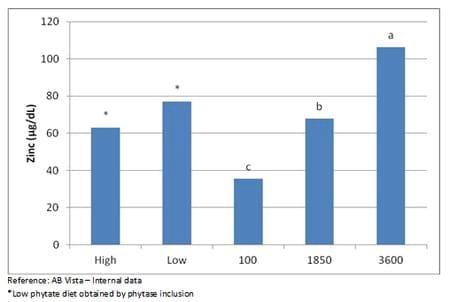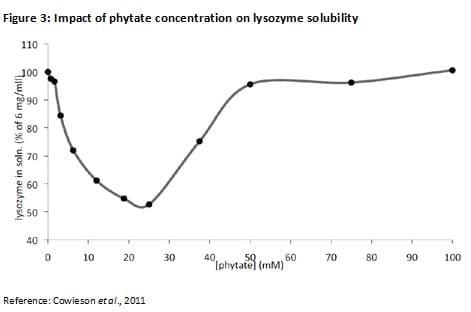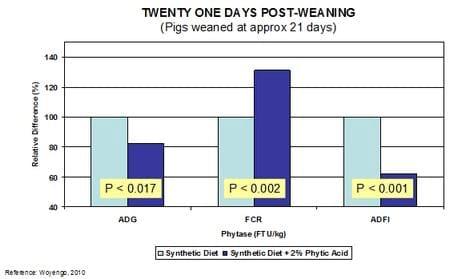Phytate as an anti-nutrient for poultry and swine
Published: October 24, 2013
By: Tiago Santos (AB Vista)
Phytate
Phytin (deposited complex of inositol hexaphosphate with potassium, magnesium and calcium), more recognized in animal nutrition as phytate, is the major storage form of phosphorus (P) present in seeds. Originally recognised as a source of P during germination, the presence of phytin in the seed during the germination process is now also known to play an important role in preventing oxidative stress and thus preventing embryo death. This is thought to be related to the ability of phytic acid to chelate minerals such as iron, calcium and zinc. This reduces the formation of reactive oxidative compounds that could be created during germination, when vegetable cells pass through a high anabolic/catabolic process.
In animal nutrition, phytate is important as a possible source of P for poultry and swine. Ruminants have a fermentation process where phytate can be broken down by bacteria, releasing P to be absorbed by the animal. However, phytate has long been recognised as a non available P “source” for poultry and swine, as monogastrics do not have enzymes to hydrolyse phytate. Actually, researchers have now shown that the low absorption of phytic P isn’t related to a lack of ability in poultry and swine to absorb this P, as low mineral diets result in phytic P absorption as high as 70%. Rather, the phytic acid molecule interacts with other minerals and proteins present in the intestinal tract, making phytic P less available (or digestible) for poultry and swine.
When reacting with other nutrients present in the intestinal tract of poultry and swine, phytate not only reduces the digestibility of these nutrients but also causes an endogenous response by the animal. Both of these effects are associated with the anti-nutritional effects of this molecule. A better understanding of the effect of phytate on nutrient digestibility and it anti-nutritional effects opens up an opportunity to improve animal performance, going beyond viewing phytate solely as a possible P source for the animal.
Impact on minerals
Phytate is a complex molecule with 12 different pKa values (acid dissociation constants), two for each phosphate group. This complex subject can be simplified by saying that even at low pH (below 2.0), the phytate molecule will still be negatively charged and will become more negative as the pH increases. This is important because when phytate passes through the digestive tract, it goes from a lower pH (in the stomach/gizzard) to neutral pH in the lower intestine. Thus, as pH increases, phytate increases its negative charge and, as a consequence, its desire to react with cations (primarily divalent cations such as calcium, zinc and copper). As a result, stable salts are formed which precipitate out of solution (illustrated in Figure 1).
Even though phytate has a higher affinity for cations such as copper and zinc, it is the affinity to calcium that causes majors concerns in animal nutrition due to the higher concentration of this mineral in animal feeds. In vivo trials have already shown that high calcium diets reduce phytic P absorption in broilers, and an increase in phytate concentration in a diet also increases the animal’s requirement for calcium. Once the amount of calcium and phytate in solution exceeds a critical concentration, salt formation and precipitation occurs, reducing the amount of calcium available in the intestine for absorption. The calcium requirement for broilers increases from 0.60% to 0.95% when the phytic P level in the diet increases from 0 to 0.25% (the latter being approximately the phytic P concentration in a standard corn-soybean diet).
Figure 1: Phytate-calcium precipitation at different pH values (2.0-7.0)

In some feeds, primarily piglet pre-starter and starter diets, copper and zinc may also be important cations where high inclusion rates of these minerals are included as growth promoters.Blood concentrations can be an indication of animal mineral status and a recent study showed that serum zinc concentrations were reduced in the presence of high phytate, suggesting that high dietary phytate may reduce the availability of zinc and potentially copper (Figure 2). This is already an important issue in human nutrition, where mineral supplementation may be necessary for diets based on a high cereal/vegetable content. In addition to piglets, animals that have a longer production period, such as turkeys, layers and sows, may also suffer from this interference, causing sub optimal levels of minerals, even though these animals often receive a high level of mineral supplementation.
Figure 2: Serum Zn concentration in piglets fed different levels of Zinc (100, 1850 and 3600ppm) and in high and low phytate diets, 21 days after weaning (*a-c P<0.05)

Impact on protein
Protein digestive processes start in the stomach, where secreted pepsinogen is activated to pepsin, the active endogenous enzyme that initiates hydrolysis of feed protein. In vitro assays have shown that the presence of phytate reduces pepsin activation between pH 0.8 and 2.8. This may result in less protein being initially digested in the acid phase of the digestive process in poultry and swine, and as a consequence impact overall protein digestibility.
Besides reducing pepsin activation, which could be overcome by higher pepsinogen production in the stomach, phytate presence also directly reduces protein solubility and consequent digestibility. The initial hypothesis to explain this reduction in digestibility is that at low pH most of the feed proteins, particularly those with high concentrations of basic amino acids, will be below their isoeletric point and thus positively charged. This would attract the protein molecule to phytate, which is negatively charged at low pH, causing an initial phytate-protein link and consequently a protein-protein link, reducing protein solubility and digestibility.
A new hypothesis proposes that this phytate-protein link does not necessarily occur as high phytate solubility at low pH would be expected to increase rather than reduce protein solubility. This hypothesis claims that the presence of phytate in solution changes the water conformation of the solution, moving water molecules closer to phytate and further away from the protein molecules (Figure 3). This lower amount of water around the protein molecule would result in a reduction in protein solubility and as a consequence lower digestibility.
Figure 3: Impact of phytate concentration on lysozyme solubility

Impact on endogenous loss
Digestive secretions are regulated by intrinsic and extrinsic stimuli. Gastric secretions of hydrochloric acid (HCl) and pepsinogen, for example, will be regulated by factors such as visual and odour stimulus, stomach distension (more important in swine than poultry) and the presence of specific components in the gut. Presence of undigested protein in the lower part of the intestinal tract will stimulate hormone secretions such as gastrin and cholecystokinin that will stimulate HCl and pepsinogen secretion in the stomach while reducing gastric empting. An increased concentration of peptides and amino acids in the lower part of the gut will have the opposite effect.
Whatever the cause, phytate can reduce protein solubility and consequent digestibility in the gut. This will result in more undigested protein reaching the duodenum, stimulating gastrin and thus HCl and pepsinogen secretion in the stomach. We have shown a lower pH in the gizzard at seven and 21 days of age in broilers fed a higher phytate diet, which is presumably related to a higher HCl and pepsinogen production in the proventriculus.
Another consequence of this increase in HCl and pepsinogen production is an increase in endogenous losses by the animal. This is because higher HCl and pepsinogen production has an irritant effect on the gut mucosa, which is compensated by an increased production of mucus as a protective layer (Figure 4). Also, once the digesta gets to the duodenum a greater amount of sodium bicarbonate needs to be secreted by the pancreas to increase pH and to compensate for the lower stomach pH. This excess sodium usage can compromise the absorption of amino acids which depend on active transportation via the Na-K pump. Phytate has been demonstrated to increase Na and sialic acid (mucus marker) excretion, as described in Figure 3.
Figure 4: Sialic acid and Na excretion (mg/bird/48 hrs) in birds fed glucose or glucose + phytate (*P<0.05)

Difficulties in measuring anti-nutritional effects of phytate
Animals, particularly swine and poultry, have always been fed diets with different phytate concentrations and thus have suffered from the anti-nutritional effects of phytate. The main problem in studying this anti-nutritional effect is how to vary the concentration of phytate in diets and determine its effect on animal physiology and performance.
Trials evaluating the anti-nutritional effect of phytate by the use of high phytate ingredients such as rice bran or comparing a vegetable diet with diets containing high levels of animal by-products have already been done. The problem with this approach is the difficulty to isolate one factor and be sure any difference in performance of animals is related to the phytate concentration of the diet rather than other differences in the composition of the feed (e.g. fibre, mineral and amino acid digestibility) when these different ingredients are included.
One possibility is to include synthetic phytic acid in the diet, artificially increasing phytate without significantly changing diet composition (Figure 5). Here, one important factor to take into account is the choice of phytic acid source. Some phytic acids have low solubility, making them less likely to cause the anti-nutritional effects seen with natural phytic acid present in vegetable feedstuffs. We have also shown that natural phytate can also vary in solubility at low pH. Thus, the anti-nutritional effects will depend on the ingredient supplying the phytate.
Figure 5: Piglet performance of animals fed low or increased concentration of phytic acid

Another possibility is to use a higher concentration of phytase in the diets, looking for a quick reduction in phytate concentration in the stomach and thus reducing the anti-nutritional effect. In this approach, as phytate hydrolysis will liberate P molecules that can be absorbed by animals, it is important to feed diets not limiting in P to be sure any improvement in performance is related to the reduction of the anti-nutritional effects of phytate and not to an increase in P digestibility. This approach is the opposite of that normally recommended when comparing or evaluating phytases. In this case, the enzyme should be included in a reduced-P diet, with enzyme activity evaluated by the improvement in performance and bone parameters resulting from the higher P digestibility.
Conclusions
Phytate has direct anti-nutritional effects for poultry and swine, causing reductions in performance by lowering amino acid and mineral absorption and increasing endogenous losses. To evaluate this anti-nutritional effect is not simple, as any change in the diet to reduce phytate concentration will result in other modifications in diet composition that what may also interfere with animal performance. One alternative is to use high levels of phytase in the diet, looking for the phytase to hydrolyse and thus reduce the anti-nutritional effects of phytate. In this case, it is important to ensure the diet is not limited in P, and to use a phytase product with a higher capacity to degrade intact phytate, which is not necessarily related to the ability to release P or even to enzyme activity determination in vitro.
Related topics:
Authors:
AB Vista
Recommend
Comment
Share
IFF - International Flavors & Fragrances
30 de noviembre de 2013
Thanks once more Tiago, very clear and good answers though the last one, due to my lack of good explanation, is not what I asked; indeed I also think phytases have different efficiacies. But my last question, here I try again: considering the same phytase - the one you talk about, let´s say - and same phytate level, would you expect even if from a practical point of view you don´t recommend, that the efficiency differs in P release?. Thanks again and greetings from Madrid.
Recommend
Reply
AB Vista
29 de noviembre de 2013
Hello Rafael,
Good to talk to you again. There are several questions here so I'll try to answer them one by one:
1) how do you come to those values - matrix values - you recommend.
Mtrix recommendation are usually calculated in a dose response trial with diets with different levels of P. Based on the performance of the treatment with phytase inclusion, the P release is calculated. Calculation for other nutrients depends a lot on each supplier as they are much more dufficult to be done in a straitforward trial.
2) are these values for avP/dP and Ca very different for poultry than for pigs?
In our research we have't seen big differences in phytase effectiveness between growing/finisher pigs and broilers. Expectoins would be layers, where phytase is more efficient, and piglets, where phytate concentration in the diet become a limitation.
3) would you say that phytases, based on the phytate nature - at same level of phytate - would have a different efficiacy?
Yes, different phytases will have different efficacies in vivo. Not all phytases are the same.
Tiago Tedeschi dos Santos
Recommend
Reply
IFF - International Flavors & Fragrances
28 de noviembre de 2013
Hello Tiago, interesting article, many thanks for sharing your knowledge with us. Since at the end of the day you would recommend to use a certain value for your phytase in the feed formulation, my question would be double: i) how do you come to those values - matrix values - you recommend and, ii) are these values for avP/dP and Ca very different for poultry than for pigs?. And last but not least, would you say that phytases, based on the phytate nature - at same level of phytate - would have a different efficiacy?. Many thanks and greetings from Madrid.
Recommend
Reply

Would you like to discuss another topic? Create a new post to engage with experts in the community.









